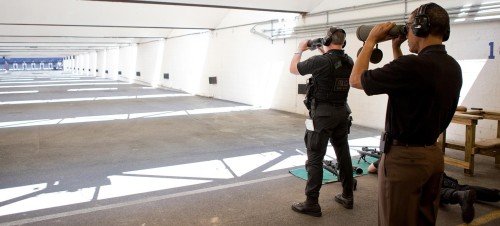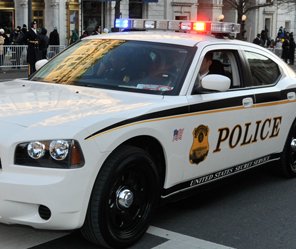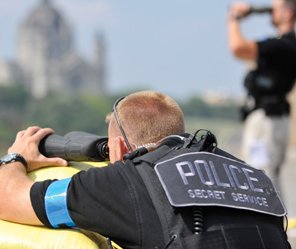The United States Secret Service (USSS) has released a Special Bidding Notice on the U.S. Government’s Federal Business Opportunities (FedBizOpp) website for a new service rifle. This bid request is for AR-15 rifles that can upgrade the Federal Agency responsible for protecting the President, and Vice President, as well as investigating counterfeiting crimes against U.S. currency or securities.
The USSS website states the Agency employes nearly 4500 armed members. This includes 3200 Special Agents, and another 1300 Uniformed Division officers. This does not include another 2000 technicians and specialists employed by the Secret Service to handle more technical matters of investigations.
The United States Secret Service Rifle Request
The acquisition of new AR-15 rifles for the Secret Service is no small matter. With the potential of arming 4500 Agents and officers this bid could be worth as much as $5-10 million, and a significant prestige by the manufacturer who lands the award. Secret Service Agents and officers require firearms that will not fail when the worst case scenarios arise. Their firearms must be rugged, durable, and have impeccable accuracy and function.

Though not the precision rifles used by Secret Service sniper/counter-sniper teams, and the incredible accuracy requirements of those rifles, this new bid will come down to manufacturers that can produce the highest quality AR-15’s with a reasonable price tag attached. The AR-15’s will no doubt be put through a rigorous testing process to ensure they meet the nation’s elite protective detail’s demands.
Currently the U.S. Secret Service’s Counter Assault Team (CAT) are the only Special Agents who are typically armed with AR-15 or M4 rifles. The Counter Assault Team is basically a Secret Service SWAT Team, EOD Team, and Paramedic Unit all wrapped up in one. Several years ago I visited the White House and got to meet some of the CAT officers. After showing my credentials they graciously allowed me to examine one of their response trucks. It was fully packed with tactical gear, EOD equipment, and the latest emergency medical supplies. I’m sure there were also other parts I was not allowed to see, but it was impressive non-the-less with what I was able to view.

The Uniformed Division has been issued variations of the M4 rifle as well, but the majority of field Special Agents do not appear to have the AR-15 or M4 as a standard issued firearm. However, this new bid seems to indicate the Secret Service is ready to all but eliminate the Heckler & Koch MP-5 sub-machine guns that Agents have been using for decades, and instead move to a single system rifle.
Though the shorter MP-5 offers a lot to Agents often required to keep their larger arms concealed, there has always been a strong debate about whether the 9mm cartridge the MP-5 fires is sufficient to stop threats to our nation’s key political leaders. The AR-15 fires the 5.56x45mm rifle cartridge at speeds and energy much higher than the 9mm. In addition, the AR-15 has been going through an impressive resurgence since the Assault Weapons Ban (AWB) expired in 2004. That has included all manners of caliber options, optic upgrades, and accessory upgrades. This includes AR-15’s with barrels as short as 9.0 inches long. With compact options like that, the move to 5.56x45mm makes perfect sense.
Here’s a good video comparing the 5.56x45mm and the 9mm rounds for overall penetration, energy transfer, effects on soft body armor, and effects going through intermediate barriers of wood, drywall, and cinder blocks.
As the video shows, common 9x19mm Parabellum ammunition has a serious over-penetration problem, while not producing the devastating effects on impact as we would hope for to stop a deadly threat. During a shooting incident where a convicted felon came out of his room with a hand grenade, one of our SWAT Team members shot five rounds on a full-auto burst into the suspect. The bullets did not expand as hoped, traveled through the suspect, through an interior wall of the house, through the exterior wall of the house, and thankfully stopped at the exterior wall of the neighboring house. The 5.56x45mm NATO cartridge, on the other hand, displaces a tremendous amount of energy upon impact, and creates legitimate wound channels that can themselves injure an adversary, unlike pistol cartridges. The 5.56mm also has a much reduced potential for over-penetration.
Though a smaller bullet, the 5.56x45mm round is capable of producing true wound channels that can damage internal areas outside of the actual path traveled by the bullet. Pistol cartridges, like the 9mm fired by the MP-5, are capable of temporary channels, but studies by Dr. Marvin Fackler and others (including the FBI) have shown the energy is not sufficient to cause permanent injuries outside of the bullet’s path.

As for handguns, the Secret Service currently issues Sig Sauer P229 chambered in .357 Sig, with some Agents fielding the FN Five-Seven pistol. Despite the FBI’s own study mentioned above, we recently posted an article on the Federal Bureau of Investigation putting out an RFP for a new service pistol chambered in 9mm. Prior to the RFP the FBI (the nation’s single largest Federal law enforcement agency) had issued their Agents Glock 22 or Glock 23 .40 caliber pistols.
In our previous article we questioned the wisdom of moving to a smaller cartridge for law enforcement users. The .40 S&W bullet is slightly larger than a 9mm, but expands even further than a 9mm upon impacting soft tissue. However, many readers thought it was bunk, and praised the improved performance of the 9mm.
We acknowledge the incredible improvements of bullet and cartridge technology over the last two decades, however physics still applies (larger hole = more injury potential = more chance at incapacitation). Obviously shot placement is a critical factor, especially for pistols rounds, but a larger pistol bullet allows a better chance at injuring critical areas of a threat.

It is very interesting to see the Secret Service moving away from 9mm the FBI is moving back towards the cartridge. Though obviously this Secret Service bid is for rifles, one could speculate about the Secret Service’s confidence in 9mm performance overall during critical incidents. Especially since the Secret Service long guns being replaced are chambered in 9mm. It would seem the Secret Service is recognizing the increased threats of targets with body armor or some other form of intermediate barrier, that will require rifle rounds to defeat. The AR-15 provides a great choice in that regard.
The New U.S. Secret Service AR-15 Specifications
Here are the specifications that have been published so far in regards to the USSS Special Bid for AR-15 rifles. Though not necessarily comprehensive, this provides a good outline of what the Secret Service is looking for. It is interesting that the Secret Service is looking to acquire as many as 10,000 rifles when the force itself is over half that number. Special thanks to soldiersystems.net for the heads up on this.
- Caliber: 5.56x45mm
- Overall Length: No more than 34.0 inches (with stock fully extended)
- Barrel Length: 10.0 – 12.0 inches
- Rifling: 5.56 x 45 mm, 1:7 RH twist
- Height: No more than 8.5 inches (without accessories)
- Weight: No more than 7.5 pounds (without accessories)
- Stock: Collapsible
- Longevity: 10 years or 20,000 rounds
- Gas System: Direct impingement or Short-stroke Piston
- Action: Select Fire – Semi and Full-auto (no burst limiter allowed)
- Fire Control: Ambidextrous, single lever adjacent to pistol grip
U.S. Secret Service AR-15 Rifle Bid Announcement
USSS Special Bid Notice on Federal Business Opportunities website
The purpose of this notice is to announce a presoliciation conference that will be held on April 04, 2016 at the United States Secret Service Headquarters in the William Wood Conference Center, 950 H Street NW Washington, DC 20235 from 9:00 AM to 11:00 PM. The presolicitation conference is designed to discuss the attached draft Statement of Work, draft evaluation, and draft testing procedures to ensure a clear understanding of the Government’s requirement with industry. This draft solicitation is for contracting with a nationwide vendor to procure rifles.
Vendors interested in attending shall provide their business size, cage code, the first and last name of each attendee, the company they represent, their telephone number, and email address by March 25, 2016 at 5:00 ET. No company may send more than three representatives. The maximum allowable attendees for the event are 40 people and will be on a first come first serve basis.
Interested parties are invited to submit questions regarding the RFP draft prior to the event by no later than March 25, 2016 at 5:00 ET. Draft documents will be provided to those that RSVP by email. Responses to the questions will be posted on FBO following the presolicitation conference. There will also be a question and answer portion at the event where vendors will be allowed to ask questions.
Attendees are asked to arrive 30 minutes prior to event to process through security.
Please note that the remarks during the conference from Government officials should not be considered a guarantee of the Government’s course of action for obtaining this requirement.
The information provided in the draft documents and conference reflects only the current Government intentions of how this acquisition should be carried out, and is subject to change based on a variety of circumstances, including input from Industry.
The final solicitation is the only document that is relied upon in determining the Government’s requirements.
All interested venders are requested to please RSVP and send questions to Mr. David Kelley at david.kelley@usss.dhs.gov by March 25, 2016 5:00 ET.
Final Thoughts
It really is not surprising to me for the Secret Service to be moving to the AR-15 as a general issue rifle. Though I loved shooting the MP-5 when my SWAT team issued those to Entry officers, the MP-5 has some serious limitations due to the 9mm cartridge being fired. There is a concern of lack of expansion, especially through intermediate barriers (even clothes), and then over-penetration. The 5.56mm cartridge fired out of the AR-15 will defeat soft body armor, which is becoming more common among hardened criminals, displays incredible expansion and energy transfer upon impact, and reduces the risks of over-penetration.
The Secret Service has used the MP-5 for decades, as did many law enforcement agencies. However, with the advancement of AR-15 designs and options, including short-barreled rifle (SBR) options as low as 9.0″ barrels, it really makes sense to make the move and switch to the harder hitting AR-15.
What do you think? How does this compare to the FBI moving away from .40 S&W and towards the 9mm in handgun?
thedarkknightreturns says
This sort of thing has become the fodder for endless debates for years and years. Ammunition technology has nearly reached a zenith with conventional projectiles. In my opinion the FBI threw the baby out with the bath water in their knee jerk response to the infamous Miami shooting their agents were involved in. If we look more closely at the details we see that the agents were armed generally with firearms that did not offer the best penetration characteristics. It has always been beyond me why we have been so stuck on revolvers in LE. It wasn’t until the 90’s that they had mostly been phased out. In my mind they have been obsolete since 1893 (see the Borchardt c93) We have had the Hi power since the 20’s the 1911 since the turn of the last century, there is no excuse in my mind why horribly outdated low capacity fiddly guns were used so long. Anyway, the agents in the shootout had some revolvers (loaded with the underwhelming .38 special “FBI load”) a shotgun and at least a couple Smith semi autos if memory serves. The thing is the 9mm semi autos were loaded with silvertips. I know they were one of the only choices back then, but we all know that you could blow on those and cause them to expand. This ultimately led them to the faulty conclusion the 9mm sucked, and the panic to create something with more horsepower for their agents. We all know the rest 10mm etc (good round but current offerings available commercially really gimp it) The truth is we have had the s-end of the stick since 9mm made its way over here commercially. Originally it was a very hot tamale. Like 124gr. at 1400fps hot. The original military load (which was based on a blown out .30 luger) was only safely usable for the most part in Sub guns and the very fine Luger P-08 pistol. They had to down load 9mm for the US commercial market, and it pretty much stayed that way for years. In reality 9mm may just be one of the most versatile rounds out there. It’s characteristics of easy handling, high capacity and good penetration particularly with new ammo offerings make it a winner in my book. So again the FBI completely missed the point, and they now (I guess) have come to their senses. The move to a 12″ barrel (ideal length in my mind as a compromise) AR15 is probably a smart one for the USSS. I am not too fond of Op-rod systems being (miss)applied to the AR platform, DI is the way to go. My favorite go to is Noveske, but honestly most of the big companies would have an offering that would fit the bill. I believe MK 318 SOST round would suit their needs as a duty load.
Aaron E says
Some great comments and insight. I agree that current ammunition is reaching its peak, but there have been some really innovative designs that still show some potential for better rounds (G2 Research, DRT, and Polycase AMX come to mind).
I think 9mm is a great round, but I’m not a supporter for its use in law enforcement. At least not in a long gun, or even a sub-gun. There are just too many potential intermediate barriers to confront. And with more and more bad guys wearing body armor, moving from the MP-5 to an AR-15 makes perfect sense, especially for the Secret Service that must have the highest probability of effectiveness.
For law enforcement pistols I can see the valid points in choosing 9mm. Cheaper costs for training, and modern 9mm is improved, so effectiveness against persons should be fine. However, it has to be understood the round won’t do well against auto glass, and some other intermediate barriers.
George says
Semi-autos were not, and in many cases, still are not as reliable as revolvers. However, a modern and well maintained auto loader, that has perhaps also received some agency armorer’s tweaking, should be quite reliable But early semi-autos were not to be relied upon as a primary defensive weapon. To this day, autos jam or otherwise malfunction when the user least expects it or needs it – on both sides of the law. .
Aaron says
George, thanks for reading and your input. Though I agree that a revolver is almost as sure to fire as you can get, the limitations on capacity is what stroke the death toll for them years ago.
Semi-autos do have a potential to experience failures in firing, feeding, and ejecting. Many of these errors are due to poor grip or trigger control by the shooter. These are conditions that can be properly trained out in most cases. In addition, modern training can have a semi-auto back in action in literally 1-2 seconds for any of those failures. With capacities as much as three times that of revolvers, and reload times easily half what a revolver requires, the semi-auto makes perfect sense for both defensive and on-duty uses.
Domenic Pastore Jr. says
Input from a ‘late comer’. Although, as we have observed, according to the FBI, the 9x19mm has been deemed the ultimate duty round, provided of course the correct loading is chosen. However, we must bear in mind that we have been told this before. Although I do profess some, limited knowledge of forensic ballistics, I don’t claim to have anywhere near the the amount of information the Bureau has amassed over their years of testing, I just can’t accept that a .355″ projectile will create more damage than a larger, heavier projectile. I feel that the rush to 9mm has somewhat more to do with the recent & current influx of Agent trainees who appear to lack any prior firearms experience. With continuing budget cuts across the board, the Bureau just doesn’t have the time ( time = money / funding ) to instruct such novices to shoot & hit a larger caliber handgun. And, as the FBI’s acceptance of the 9mm becomes more widely know, additional U.S. Agencies will take advantage of the reduced cost, training time, & weapons wear issues, to jump on the 9mm bandwagon. ( As we have seen with the recent US customs & BP contract. ) Perhaps due to my being somewhat older, I’ve observed these ‘caliber wars’ for quite a few years now. One important lesson I’ve learned from them is that no particular caliber / load is ‘the perfect one’. I remain certain that perhaps in 8 -10 years down the , we’ll be discussing this very same issue all over again. Maybe this time around, we will see a fair amount of venom shown when mentioning the late, great 9mmm ! Let’s do hope our new Officers & Agents learn to shoot well with their new issue 9’s, & to take advantage of it’s more controllable nature.